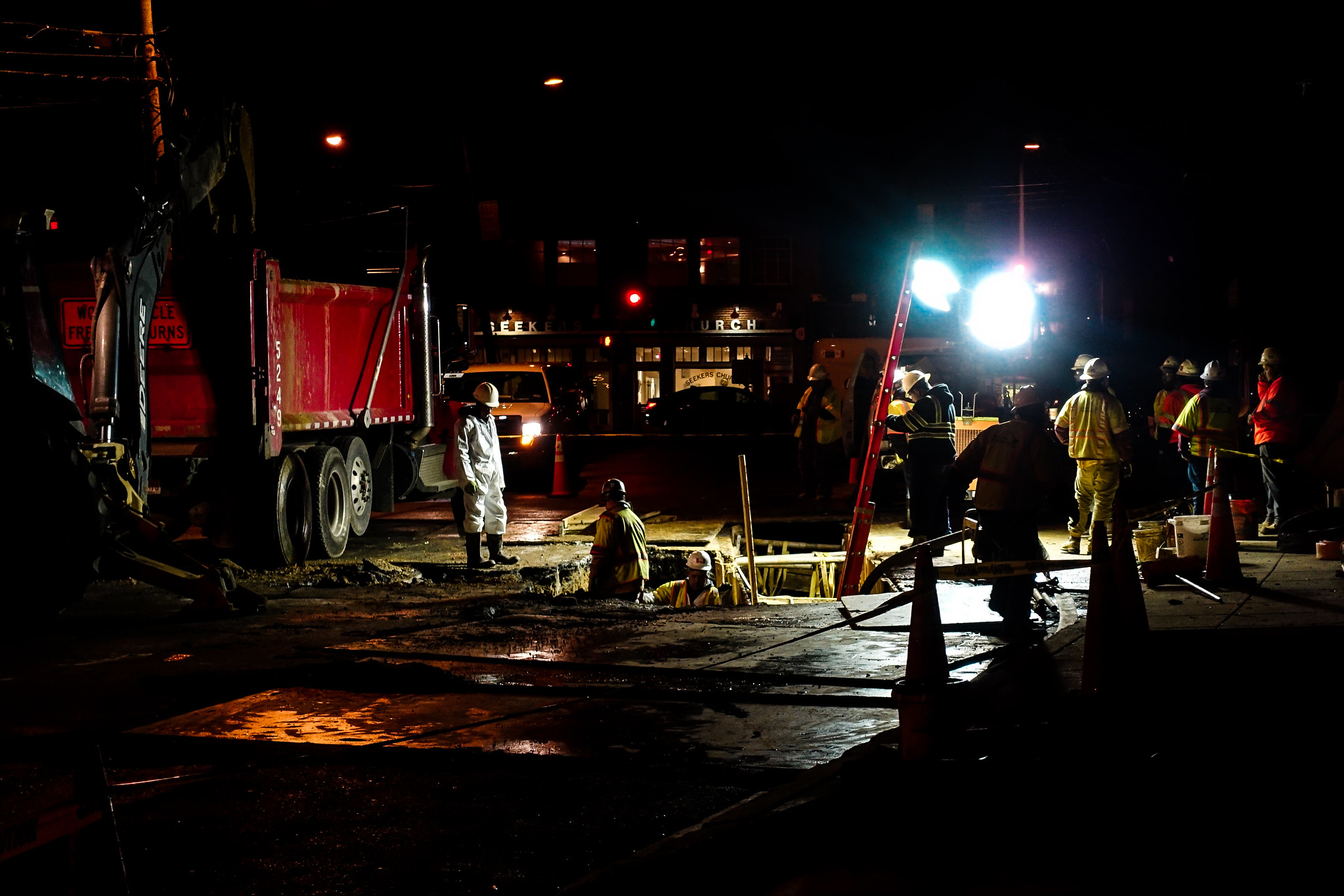Texas has the second largest percentage of Latinx voters in the country. Yet despite Donald Trump’s deep-seated racism toward brown people, Texas went bright red in November. Trump beat Kamala Harris 58% to 42%.
But Texas is not all red. In a small illustration of the complexities of such numbers, now being chewed to mush by national pundits, Travis County, Texas has a Democratic district attorney, Jose Garza. Garza previously worked in Congress and at the Labor Department, and is the former Executive Director of the Workers Defense Project, a statewide organization advocating for immigrant rights and worker justice.
Last month, Garza — who was just re-elected in a landslide — filed one of the country’s handful of criminal cases motivated by a typically hideous death in a trench. A grand jury charged D Guerra Construction LLC and Carlos Gerrero, the supervisor at the site, with criminally negligent homicide in the death of Juan Galvan Batalla, 24.
“All workers here in Travis County deserve to be safe at work so they can return to their families at the end of the day,” Garza said.

If more local governments had prosecutors like Garza, workplaces in industries like construction, meatpacking, and refineries would be safer and people in dangerous jobs could endure the havoc the incoming administration plans to wreak on OSHA, the Department of Labor, and the National Labor Relations Board. (A petition to dismiss Garza from office for not prosecuting certain Texas laws was dismissed last week, shortly after his landslide victory in last month’s elections.)
Double Jeopardy
On October 23, 2021, Galvan Batalla was working in a 13-foot trench installing a residential wastewater line. This trench was deep. It was not shored–it had no walls or braces strong enough to prevent the collapse of its dirt walls – an OSHA requirement for any trench more than 5 feet deep.
This tragedy was no surprise. The walls began to crumble earlier in the day and employees scrambled out. In the afternoon, without remedying the problem, supervisor Gerrero ordered the men back into the trench to continue work. The walls collapsed on top of Batalla, burying him in dirt. Remarkably, he was still alive when rescue crews arrived, dying seven days later at the hospital, an experience as excruciating for him and his family as his death was needless.
The walls began to crumble earlier in the day and employees scrambled out. In the afternoon, without remedying the problem, supervisor Gerrero ordered the men back into the trench to continue work. The walls collapsed on top of Batalla, burying him in dirt.
It’s a common misunderstanding that if a trench collapses on a worker, you can dig him right out and everything will be fine. The truth is that a cubic yard of wet dirt weighs 3,000 pounds, about the weight of a small car. So, if the initial collapse doesn’t crush a worker to death, they will likely suffocate soon after.

In addition, it’s not easy to dig someone out of a trench. Workers can’t just jump and start digging because the trench may continue to collapse, entrapping the rescuers. In 2003, a worker buried in a trench collapse was decapitated when workers tried to rescue him with a tractor.
And as we have seen in Galvan Batalla’s case, even if a worker can be dug out alive, the resulting injuries are often fatal.
It’s the Money, Stupid
The risks are so obvious that 2300 years before OSHA — Herodotus wrote about how the Phoenicians had figured out how to prevent trench collapses that were plaguing their army.. No one—NO one—who digs trenches or hires people to dig trenches should be confused about these dangers or readily available solutions.
OSHA has a strong trenching standard. Options to protect people digging or working in trenches that are over 5 feet deep include sloping the sides; benching the trench by constructing the walls into a series of steps or levels; shoring dirt and debris with restraining structures; or shielding workers with boxes that protect them from collapsing walls. Companies all over the country rent, deliver, and install such structures.
There is plenty of material on the OSHA website, and as I’ve pointed out many times before, OSHA’s trenching and excavation webpage provides information on trenching hazards and solutions, including a safety video. (Or you can do a Google search under “trench safety” which will conjure up about 10 million hits in half a second.)
Why ignore such options? The obvious answer is to avoid the expense. If the employer doesn’t own a trench box, they will have to rent one. It takes longer to use a trench box and dig a trench wide enough to fit the trench box. Employers who are on a deadline or just want to save a few bucks figure they’re better off relying on luck than complying with life-saving OSHA standards.
The less obvious reason is the magical thinking that the two defendants in this case exhibited. Consider the comments of Scot Courtney, the attorney representing Gerrero, the supervisor who ordered Galvan Batalla back into a trench that was already shifting: “Nobody did anything intentionally. A jury will ultimately have to decide whether my client is a criminal for doing his job.” He added that the incident was “a tragedy” and an “accident.”

It’s common to refer to workplace fatalities as “accidents.” But the word does not describe accurately the countless incidents that kill and injure workers in a trench. An “accident” is an “unforeseen and unplanned event or circumstance.” The word can also mean “an unfortunate event resulting especially from carelessness or ignorance.”
Again, no construction company in this country should be able to argue after the fact that it was ignorant about hazards of bare dirt trenches. No supervisor on a job site should ignore these hazards. And under any reasonable interpretation of the law, neither D Guerra Construction LLC nor Gerrero should be able to argue that this tragedy was unforeseen or unplanned when the trench started to collapse the morning the victim died.
Why Criminal Law?
When you think about it, the above statements reflect the hazardous conditions that afflict most workers in industrial jobs. Nursing home owners know that lifting patients causes severe ergonomic injury. Refinery owners and operators know that wells blow out and that aging equipment and poor training are often to blame for deadly incidents. Health care workers are vulnerable to infectious diseases without protective equipment, as hospital management knew long before the COVID 19 pandemic.
Well-funded government agencies with aggressive enforcement programs could motivate recalcitrant management into compliance. But underfunded regulators lack the authority or the resources to create an atmosphere where employers committed to cheap, fast, dangerous work fear prosecution. Scofflaw has seeped into every corner of hazardous work because the money is good and the chances of getting caught, much less adequately punished, are remote, even when workers die.
Scofflaw has seeped into every corner of hazardous work because the money is good and the chances of getting caught, much less adequately punished, are remote, even when workers die.
Investigative journalists at National Public Radio, Texas Public Radio, and radio program 1A authored a comprehensive article about trench hazards published in July 2024. Among other discouraging facts, it revealed that 250 workers died in trench collapses over the last decade.
Because most trenches are small jobs hidden in the yards of suburban houses, or behind wooden fences in construction projects, OSHA has little chance of ever finding most of them before it’s too late.
The agency and its state partners are responsible for more than almost eleven million workplaces and 158 million workers. Because of drastically inadequate funding, if federal OSHA were able to inspect every workplace under its jurisdiction, it would take 186 years. Even so, OSHA , and that small number is still 6% of all the workplace inspections the agency does in a given year.
Without a referral by OSHA or other experts, local prosecutors may hear about fatal incidents through the news but are unlikely to recognize whether the employer is responsible until months later when an OSHA citation is issued.
It’s not easy to win a criminal case. Negotiated settlements, or “plea bargaining” resolve 98% of federal and 95% of state criminal cases. When prosecutors go to trial, they must prove two things: first, that the defendant committed an act defined as criminal under the law (“actus reus”), whether or not the defendant knew the act’s legal status. And, second, that the defendant committed the criminal act purposely, knowingly, recklessly, or negligently (“mens rea”). And, as we all know from watching police and lawyer procedurals on television, the standard of proof in criminal cases is the highest in the law—prosecutors must show that the defendant is guilty “beyond a reasonable doubt.”
Garza’s case depends on a specific class of charges known as “criminal negligence,” or such a gross deviation from the “standard of care” that a “reasonable person” would know the behavior was wrong. Or, in other words, if a company and its supervisor were or should have been aware of trench dangers and they nonetheless ordered the employees to work in that situation, they have the mens rea to be found guilty.
He charged the case as a felony, although such cases can also be charged as misdemeanors under state law. Criminal negligence is one way to approach a case involving a trench death, but prosecutors can reach even further and charge manslaughter, which is always deemed a felony and carries imposes harsher sentences. Neither is the same as murder, which requires proof that the act of killing was premeditated and therefore intentional.
Unfortunately, one of the many weaknesses in the OSH Act is that criminal behavior is punished in a ridiculously pitiful way. Only if an employee is killed in the workplace, and OSHA issues a willful violation, is the employer eligible for criminal prosecution.
If the employer is convicted under the OSHA Act, the penalty is $10,000 or imprisonment for not more than six months. Because of the small penalties, a convictions are classified as misdemeanors. refers such cases to the Department of Justice (DOJ) (the agency cannot go to court on its own), DOJ lawyers often decline the enormous time and resources that go into a criminal prosecution aren’t worth it if the ultimate result of a winning case is only a misdemeanor. Consequently, only 137 worker deaths case have been criminally prosecuted under the occupational Safety and Health Act since 1970.
Another yawning gap in the OSH Act discussed often in this space is the failure to protect public employees in 23 states who dig and work in trenches facing the same hazards as their private counterparts. As much as we might hope that government supervisors were more careful than the private sector, they can be just as cheap.
OSHA Did the Right Thing
Federal prosecutors are not the laboring oar in the criminal system. State and local governments do most of the work. To put these facts in context, about 157,000 inmates are incarcerated by the federal government and 1.8 million are in state or local jails.
Although only willful violations serve as a basis for criminal charges under the Occupational Safety and Health Act, state and local prosecutors are not limited by this restriction and may charge crimes justified by the facts.
By far the most important OSHA contribution to worker safety was its decision to refer the case to DA Garza’s office in 2022.
It’s clear to everyone that OSHA’s monetary penalties are not adequate. After Galvan Batalla’s death, OSHA charged D Guerra Construction in April 2022 with five violations, proposing $243,406 in penalties, the bulk of which was imposed for “willful” violations. (In a settlement, the company’s fine was reduced to $140,000.)
But even after killing Galvan Batalla, the company still had not learned its lesson. In 2023, D Guerra was cited twice more for yet again violating OSHA’s well-understood trench standard – the total penalties amounting to less than $25,000.
As former OSHA Deputy Assistant Secretary Jordan Barab frequently says, nothing sharpens the mind like the prospect of prison time.
But as former OSHA Deputy Assistant Secretary Jordan Barab frequently says, nothing sharpens the mind like the prospect of prison time.
And the effect of criminal prosecutions can stretch beyond changing one employer’s behavior. David Michaels, OSHA’s Assistant Secretary during the Obama Administration, explained in the NPR article that “If employers see that an employer is sent to jail because a worker is sent to a trench, that will have a much bigger impact on them than fear of an OSHA fine.”
The next few years are going to be difficult for people concerned about workers, their safety, their long-term health, the illegal employment of children, wage theft, raising the minimum wage, organizing, and a slew of other issues. The United States has government at all levels and as the above story indicates, voters elect people with profoundly different views. Unions and labor advocates can work with progressive local prosecutors to advocate for criminal prosecutions when workers are killed on the job and save thousands of lives.
For every J.D. Vance, there may well be a Jose Garza.
